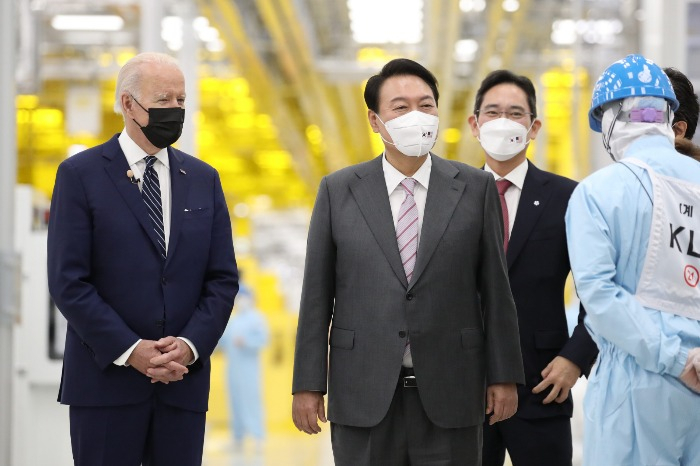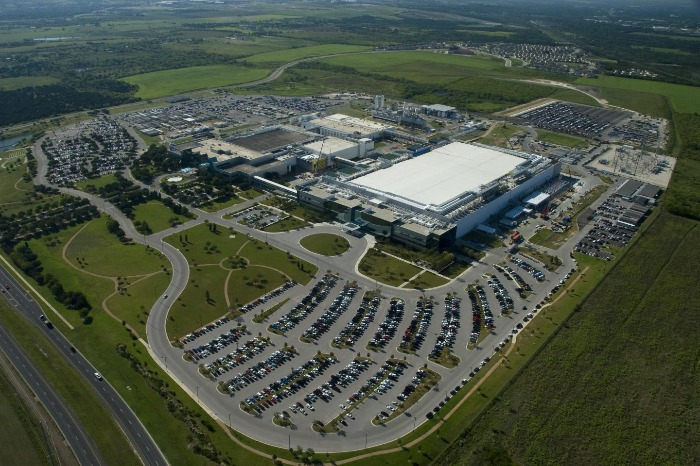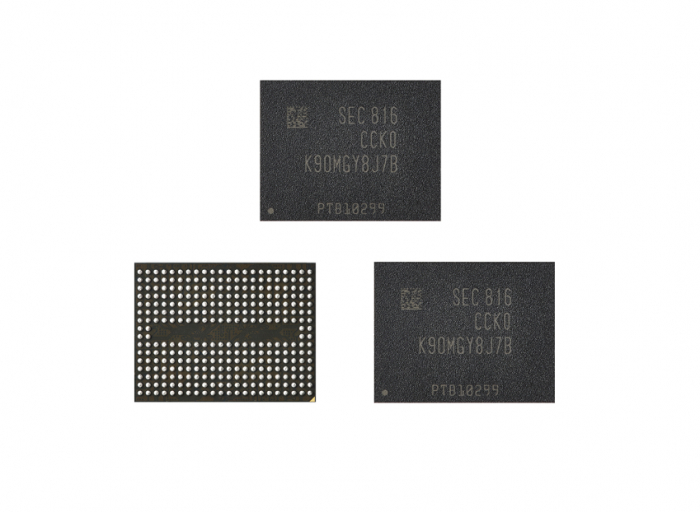Korean chipmakers
S.Korea edges closer to joining US-led chip alliance
Samsung and SK Hynix are jittery about the impact of tougher US measures against China
By Aug 02, 2022 (Gmt+09:00)
long read
Most Read
Alibaba eyes 1st investment in Korean e-commerce platform


Blackstone signs over $1 bn deal with MBK for 1st exit in Korea


Korea's Lotte Insurance put on market for around $1.5 bn


OCI to invest up to $1.5 bn in MalaysiaŌĆÖs polysilicon plant


NPS loses $1.2 bn in local stocks in Q1 on weak battery shares



August could mark a turning point for South KoreaŌĆÖs semiconductor industry.
The country has been keeping tight-lipped on whether or not to join the four-country chip supply chain alliance led by the US, but it needs to deliver its decision to Washington by the end of this month.
High-ranking Korean officials recently hinted at the government's intention to participate in the group, including Japan and Taiwan.
Last week, Prime Minister Han Duck-soo said in a local radio program that it is necessary to see the positive side of the four-country alliance, which would make it easier for Seoul to share information and strengthen cooperation among the member countries, as well as take a leading role in setting relevant rules.
The proposed four-country country follows ChinaŌĆÖs massive spending to develop semiconductor technologies, which would increase its influence over the sectorŌĆÖs supply chains. Now the US is trying to bolster its partnership with major semiconductor chipmakers in Asia to counter ChinaŌĆÖs rise in the sector.
Their alliance is also part of diplomatic efforts to isolate China from the global semiconductor ecosystem.
Still, South Korea seems to be walking on a tightrope between the US and China, analysts say.
For South Korea, keeping a good relationship with China is as important as strengthening its economic security alliance with the US as emphasized during US President Joe Biden's visit to Seoul last May.
China is a major customer of South Korean chipmakers and also the venue of their manufacturing facilities. ChinaŌĆÖs ban on chip imports from South Korea would take a heavy toll on the Korean semiconductor industry.
To deal with such a challenging situation between the US and China, industry insiders said South Korea needs to further enhance its semiconductor technologies and production capabilities. That will eventually lead to South Korea exercising more influence over diplomacy and security in the world.
Alongside the chip alliance, competition is heating up among chipmaking countries, which have earmarked heavy spending to gain greater control over semiconductor supply chains.
This week, South Korea is set to introduce a special law regarding the semiconductor sector. Under the law, Asia's fourth-largest economy will unveil supportive measures, including big budgets, to strengthen semiconductor supply chains and advance technologies in the sector.
RISE OF CHINESE CHIPMAKERS AND THREAT TO THE US
Back in 2020, the US drew up a plan to form a four-country semiconductor alliance. The previous year, China overtook the US in the market share of semiconductor chip production for the first time in history.
China made up 13.9% of the global semiconductor production in 2018, beating the US with a 12.8% share, according to research firm IC Insights. ┬Ā
ChinaŌĆÖs semiconductor market value more than doubled in a decade from $57 milion in 2010 to $143.4 billion as of 2020.┬Ā
In particular, the average growth rate of ChinaŌĆÖs chip industry has risen to as high as 12% a year since 2016, double the 6% of the entire semiconductor industry during the same period, according to the World Semiconductor Trade Securities.

Behind the rapid growth was the Chinese governmentŌĆÖs supportive measures with the catchphrase ŌĆ£Made in China 2025.ŌĆØ The measures, announced in 2015, revealed ChinaŌĆÖs ambitious goals of bringing its self-sufficiency rate for semiconductor chips up to 40% by 2020 and 70% by 2025.
To achieve the goals, China has mobilized various policy tools. In 2019, it opened a stock market dedicated to technology and startups, on which 197 Chinese companies are traded, including its largest foundry company SMIC and Cambricon Technology, an artificial intelligence chipmaker. ┬Ā
The bourse served as a key funding channel for Chinse semiconductor-related companies.
Before that, China launched a 138.7 yuan ($25 billion) fund in 2014 to invest in semiconductor startups and R&D in the industry, followed by the 2019 launch of a 200 billion yuan fund.
The Chinese finance ministry, its development bank and state-run banks injected money into the big funds.
The faster-than-expected growth in ChinaŌĆÖs semiconductor industry took the US government and its chipmakers aback.
Global chip shortages beginning in 2020 raised the US' awareness of their heavy reliance on semiconductor chips produced in China and other Asian countries.
That was because American semiconductor companies, including Qualcomm and Nvidia, had moved their production lines to Asia to cut labor costs. The lack of semiconductor production facilities within the US made it difficult for American carmakers such as GM and Ford to secure automotive chips.
Moreover, outsourcing chip production to Asia could cause leakage of some semiconductor technologies, crucial to Washington, to China.
KEEPING CHINA IN CHECK
The Trump administration banned US semiconductor equipment suppliers such as Applied Materials and Lam Research from selling semiconductor equipment to SMIC and other Chinese chipmakers.
Washington also pressured the Dutch government to put ASML HoldingŌĆÖs shipment of extreme ultraviolet (EUV) lithography machines to China on hold. ASML is the worldŌĆÖs only producer of EUV machines, which pattern the finest lines on semiconductor wafers.
Recently, the US government zeroed in on NAND Flash chip manufacturing equipment on concerns that ChinaŌĆÖs flash memory chipmaker YMTC might catch up to its US rivals this year. NAND is a non-volatile memory chip for use in smartphones and storage devices such as USB.

Such moves kept China from developing advanced chip processing technologies and therefore chips produced in China remain mainly low-end memory chips and analog chips used for desktop computers.
The US is ratcheting up pressure on ASML to stop its shipment of deep ultraviolet (DUV) lithography machines to China as well. DUV is used to produce chips installed in automobiles, smartphones and PCs.
TECHNOLOGY VACUUM
The US governmentŌĆÖs move has dealt a heavy blow to China and has widened its technology gap with other countries. Earlier this year, Peking University said in a report that the US policies aimed at isolating Chinese chipmakers added pressure on the country to secure advanced technologies and chip talent in the fields of semiconductor manufacturing and artificial intelligence.
Now South Korea is between a rock and a hard place, needing to avoid uncomfortable relations with either China or the US. ThatŌĆÖs why South Korea has been delaying its response to the US proposal for a four-country chip alliance, in which Japan and Taiwan already confirmed their participation.
If Seoul becomes an alliance member, it may take the risk of economic retaliation from China, which takes the biggest portion of South Korean semiconductor shipments.
Samsung Electronics Co. produces 40% of NAND Flash chips from China. For SK Hynix Inc, China accounts for half of its flash memory chip output.
South KoreaŌĆÖs chip exports to China amounted to a whopping $17 billion in the first half of this year, more than five times the $4.4 billion worth of Korean chips shipped to the US.
However, South Korea appears to be leaning toward joining the US-led semiconductor alliance.
On July 27, Foreign Minister Park Jin told a press conference with foreign correspondents that South KoreaŌĆÖs decision will be made in the national interest. Also, he rephrased the semiconductor alliance to be a ŌĆ£cooperation between major semiconductor chipmakers.ŌĆØ
ŌĆ£If China gets us wrong, we need to make diplomatic efforts to resolve the misunderstanding.ŌĆØ
ParkŌĆÖs remarks come ahead of his first visit to China as a foreign minister later this month.
Recently, ChinaŌĆÖs foreign ministry cautioned that South Korea may need to contribute to stabilizing the global industry networks and supply chains.
Earlier this year, the Biden administration introduced a $28 billion bill to develop the US semiconductor industry and relevant technologies. It is expected to benefit not only American chipmakers such as Intel but also Samsung and TaiwanŌĆÖs TSMC, which run production facilities there.
Samsung, the worldŌĆÖs top memory chipmaker, has already announced a plan to invest about 250 trillion won to build 11 chip manufacturing plants in Texas over the next 20 years, including a $17 billion foundry plant expansion in the state.
SK Group, parent of SK Hynix, last week pledged an additional $22 billion investment in the US, including $15 billion earmarked for building its first chip package facilities and R&D projects for the semiconductor industry.
However, both Samsung and SK Hynix are jittery about any adverse impact of the US governmentŌĆÖs efforts to block NAND Flash equipment supplies to China, in addition to those for DRAM chips.
ŌĆ£Now we need to convince the US government of the need to ship NAND Flash manufacturing equipment to our Chinese plants,ŌĆØ said a semiconductor industry official.
Separately, SK Hynix on Tuesday announced the completion of its 576 billion won acquisition of Key Foundry from Magnus private equity firm, which is expected to double its foundry capacity.
Write to Shin-Young Park and Ji-Eun Jung at psy@hankyung.com
Yeonhee Kim edited this article.
More to Read
-
 Corporate investmentSK to build first chip packaging plant in US with $22 bn investment
Corporate investmentSK to build first chip packaging plant in US with $22 bn investmentJul 27, 2022 (Gmt+09:00)
4 Min read -
 Korean chipmakersSamsung presents Texas with $200 bn chip investment plan proposition
Korean chipmakersSamsung presents Texas with $200 bn chip investment plan propositionJul 22, 2022 (Gmt+09:00)
3 Min read -
 Corporate investmentSamsung to invest $355 billion in chip, biotech, 6G over five years
Corporate investmentSamsung to invest $355 billion in chip, biotech, 6G over five yearsMay 24, 2022 (Gmt+09:00)
3 Min read -
 Business & PoliticsYoon, Biden highlight 'economic security alliance' following Samsung tour
Business & PoliticsYoon, Biden highlight 'economic security alliance' following Samsung tourMay 20, 2022 (Gmt+09:00)
5 Min read
Comment 0
LOG IN


